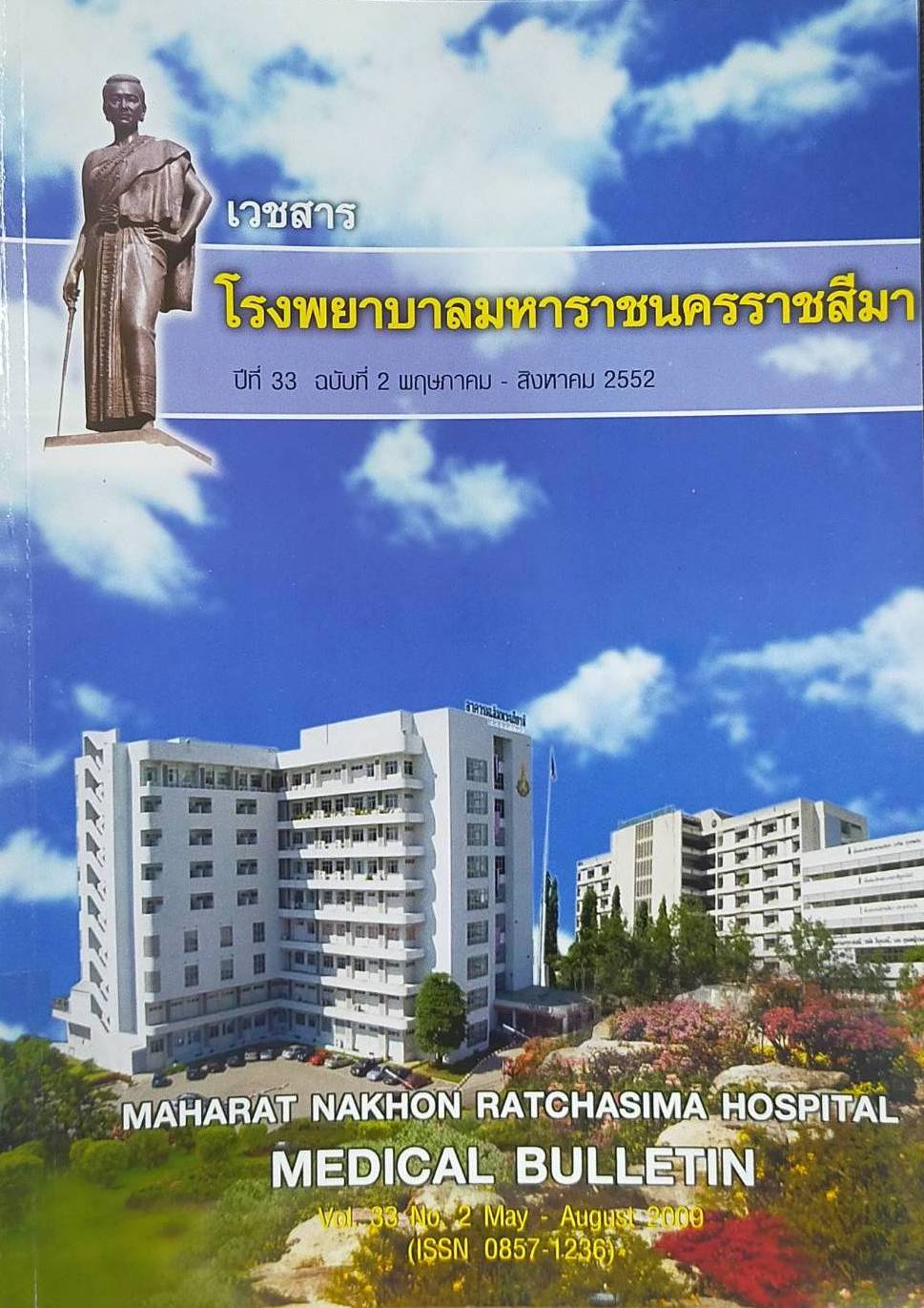Atypical Computed Tomography Feature and Unusual Location of Intracranial Meningiomas in Maharat Nakhon Ratchasima Hospital
Main Article Content
Abstract
Objective: The purpose of the study was to review atypical computed tomography (CT) features and unusual locations of intracranial meningiomas that could lead to misdiagnosis in Maharat Nakhon Ratchasima Hospital. Patients & Methods: This was a retrospective descriptive study of the meningioma patients who were pathologically proven in Maharat Nakhon Ratchasima Hospital during January 1, 2006 to December 31, 2008. CT of brain with contrast study of all patients was reviewed. The CT scan findings were evaluated for the unusual locations and atypical features of the tumor. Results: We had 24 patients with atypical CT scan features and unusual locations of meningiomas, 5 males and 19 females. The ages ranged from 31-79 years and the average patient age was 50.0+12.0 years. CT scan with atypical features of tumors were found in 20 cases. Central necrosis 20%, hemorrhagic meningioma 20%, cystic meningioma 20%, ring enhancement 15%, en plaque meningioma 10%, multiple meningiomas 10% and bone invasion 5.0% were recorded. Unusual locations were observed in 8 of 24 patients, i.e. lateral ventricle 50%, cerebellopontine angle 37.5% and orbital region 12.5%. Four of 8 patients had both atypical CT features and unusual locations. Conclusion: Atypical CT features and unusual locations of intracranial meningiomas in Maharat Nakhon Ratchasima Hospital were found 24%. The majority of them were female, mean age 50+12 years. Atypical CT features were tumor with central necrosis, hemorrhagic tumor and cystic tumor with ring enhancement about 20%, 20%, 20% and 15 %, respectively. Unusual locations were ventricles and cerebellopontine angle, about 50% and 37.5%, respectively.
Article Details

This work is licensed under a Creative Commons Attribution-NonCommercial-NoDerivatives 4.0 International License.
References
Osborn AG. Meningiomas and Other Nonglial neoplasms. In: Patterson AS, editors. Diagnostic Neuroradiology.2nd ed. St.Louis. Mosby; 2000. p.579-624.
Scott WA, Ehud L, Herbert IG. Extraaxial brain tumor. In: Scott WA editors. Magnetic Resonance Imaging of the Brain and Spine. 3rd ed. Philadelphia. Lippincott Williams & Wilkins; 2002. p.695-772.
Smirniotopoulos JG, Lee SH. Primary tumor in adults. In: Lee SH, Rao K, Zimmerman RA, editors. Cranial MRI and CT. 3rd ed. New York: McGraw-Hill, Inc; 1992. p. 295-380.
Katzman GL. Section 4: skull, scalp and meninges. In: Osborn AG, editor. Diagnostic Imaging of Brain.1st ed. Utah: Amirsys Inc; 2004.p.456-71.
Wood MW, White R, Kernohan J. One hundred meningiomas found incidentally at necropsy. J neuripathol Exp Neurol 1957; 16: 337-40.
Rausing A, Ybo W, Stenflo J. Intracranial meningioma: a population study of ten years. Acta Neurol Scand 1970; 46(1); 102-10.
Greenberg SB, Schneck MJ, Faerber EN, Kanev PM. Malignant meningioma in a child: CT and MR findings. Am J Roentgenol 1993; 160: 1111-2.
Buetow MP, Buetow CP, Smirniotopoulos JG. Typical, atypical and misleading features in meningioma. Radiographics 1991; 11: 1087-106.
Russell EJ, George AE, Kricheff II, Budzilovich G. Atypical computed tommographic features of intracranial meningioma. Radiology 1980; 135: 673-82.
Lichtenstein JE, Alspaugh JP, Blebea JS, Donnelly LF, Gasparaitis AE, Jones BV, et al. Image interpretration session: cystic meningioma. Radiographics 1996; 16: 215-39.
Wasenko JJ, Hochhauser L, Stopa EG, Winfield JA. Cystic meningiomas: MR characteristics and surgical correlation. Am J Neuroradiol 1994; 15: 1959-65.
Wakai S, Yamakawa K, Manaka S, Takakura K. Spontaneous intracranial hemorrhage caused by brain tumor: its incidence and clinical significant. Neurosurg 1982; 10: 437-44.
Weisberg LA. Hemorrhagic primary intracranial neoplasm: clinical-computed tomographic correlations. Comput Radiol 1986; 10: 131-6.
Destian S, Sze G, Krol G, Zimmerman RD, Deck MD. MR imaging of hemorrhagic intracranial neoplasm. Am J Roentgenol 1989; 152: 137-44.
Lang I, Jackson A, Stang F. Intraventricular hemorrhage caused by intraventricular meningioma: CT appearance. Am J Neuroradiol 1995; 16:1378-81.
Dahnert W. Radiology Review Manual. 3rd ed. Philadelphia. Lippincott Williams & Wilkins; 2003.
Kim KS, Roger LF, Goldblatt D. CT feature of hyperostosing meningioma en plaque. Am J Roentgenol 1987; 149: 1017-23.
Kim KS, Rogers LF, Lee C. The dural lucent line: Characteristic sign of hyperostosing meningioma en plaque. Am J Roentgenol 1983; 141: 1217-21.
Bradac GB, Ferszt R, Kendall BE. Cranial meningiomas. Berlin: Springer-Verlag, 1990.
Koeller KK, Sandberg GD. Cerebral intraventricular neoplasms: Radiologic–pathologic correlation. Radiographic 2002; 22: 1473-505.
Morrison G, Sobel DF, Kelley WM, Norman D. Intraventricular mass lesions. Radiology 1984; 153: 435-42.
Tien RD. Intraventricular mass lesions of the brain: CT and MR findings. Am J Roentgenol 1991; 157: 1283-90.
Jelinek J, Smirniotopoulos JG, Parisi J, Kanser M. Lateral ventricle neoplasms of the brain: differential diagnosis based on clinical, CT and MR findings. Am J Neuroradiol 1990; 155: 365-72.
Strenger S, Huang Y, Sachdev V. Malignant meningioma within the third ventricle: a case report. Neurosurgery 1987; 20: 465-8.
Kloc W, Imielinski BL, Wasilewski W, Stempniewicz M, Jende P, et al: Meningiomas of the lateral ventricles of the brain in children. Childs nerv Syst 1998; 14: 350-3.
Sgouros S, Walsh A, Barber P. Intraventricular malignant meningioma in a 6 years old child. Surg Neurol 1994; 42: 41-5.


